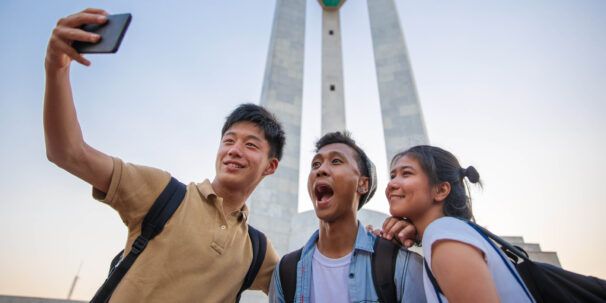Why study in the Philippines?
Discover reasons to study in the Philippines, the top Philippines universities, and tips to help your application.

The Philippines, an archipelago in Southeast Asia, is a country where urban and natural environments meet the sea. Although the Philippines appears to have a huge land area, its real land area is quite small, making it a highly populated country perfect for exploration by tourists and international students alike.
In this article, we’ll explore the advantages of studying in the Philippines, the top universities in the Philippines, and the cost of living in the Philippines as a student. If you’re preparing for university study, you may want to consider the country as a destination.




An overview of the Philippines as a study destination
In 1898, the Philippines gained independence for a brief period before being handed over to the United States. In 1946, it declared independence from the United States. The Philippines’ distinct identity stems from its modern history: Filipino culture is a wonderful blend of Spanish and American cultural traditions and influences, as well as distinct regional cuisines.
The Philippines’ natural beauty draws travellers from all over the world. Crystal blue lagoons, jungles and coastal mountain springs can be found all over the islands.
The Philippines is a popular study destination for international students, particularly those from Asia. It also draws students from other continents seeking low-cost tertiary education in a unique setting.
English is widely spoken in the Philippines and the government invests in study programmes that are advantageous and appealing to international students.
3 reasons to study in the Philippines
1. It’s affordable
What is the cost of a degree in the Philippines?
You will not need to break the bank to obtain a degree in the Philippines. When compared to major study locations such as the United States or the United Kingdom, the country has affordable tuition fees. Living costs are very low, allowing you to spend more money on travel and exploration of the islands.
Filipino schools are free to determine their own tuition costs. Most schools, however, set their prices between $1000 and $2500 per academic year to keep them competitive. Medical and engineering courses will be on the higher end of this spectrum.
Fees are largely consistent across all three levels of higher education. Fees are payable in Pesos via bank giro or international wire transfer. The receipt must be kept for immigration purposes.
Scholarships are usually only given to students from the Philippines. However, many schools provide their own scholarships to international students. These might range from a fixed amount each semester or year to a complete scholarship. Check the scholarship options of any schools to which you are considering applying.
What is the cost of living in the Philippines?
For international students, the Philippines has a low cost of living when compared to many other countries. Manila is extremely inexpensive compared to London or New York.
The average monthly cost of living in Manila, without rent, is around PHP28,200. Rent is typically treated as a separate expenditure in the Philippines, as it is in many other parts of the world.
You can live in residences – often known as dorms or corridors in North America and Europe – to save money on rent. Private rooms can cost twice as much as shared ones. However, until you receive your SSP (Special Study Permit), you’ll need to find a small, inexpensive room in a hostel or hotel.
You can use state healthcare in the Philippines once you get your SSP. Medical staff are well-trained, but facilities, particularly outside of major cities, can be lacking. As a result, many international students opt for private medical insurance. Once you’ve landed in the Philippines, you can purchase this for a reasonable price. Providers will be able to easily assist you in navigating the healthcare system, as English is one of the official languages of the Philippines.
Food expenses vary depending on whether you splurge on imported brands from back home or go for less expensive local ones. Local daily markets, which are filled with fruit, vegetables, meat, and seafood, are the most cost-effective way to shop. It’s not just cheap, it’s also fresh.
Eating out is also not too expensive. A meal of barbecue pork and rice with a beer costs around PHP180 in local restaurants. A cappuccino will set you back roughly PHP110, while a three-course meal for two would set you back PHP780.
2. English is a national language
When studying abroad, not knowing the local language can rapidly become a challenge, especially if English is not commonly spoken. Fortunately, you will not experience this problem in the Philippines. English is the default instruction language in all educational institutions in the country, from kindergartens to universities.
This will also greatly help with socialising and travelling. On a night out, you can simply strike up a conversation with locals, ask for directions, or order whatever you like.
3. The weather
After lectures, students can relax and unwind on stunning beaches with clear oceans and vibrant coral reefs. Exam stress will be a thing of the past, given the sunny weather and tropical climate. If you don’t want to travel to the beach, visit other natural attractions such as rainforests, mountains and beautiful waterfalls.
When deciding where to study in the Philippines, it’s a good idea to take local weather systems into account. Because of their proximity to the Pacific Ocean, the eastern Visayas have the most rainfall and typhoons throughout the year, whilst the northern island of Luzon has a warmer and drier environment.
Weather systems and climate can be affected by altitude. By May, average temperatures in some sections of the country, particularly in Manila and the lowlands, might exceed 32°C. Due to their great height, Baguio and the Cordillera region in northern Luzon are substantially cooler.




What can I expect from studying in the Philippines?
The American system has had a significant influence on higher education in the Philippines. The majority of degrees take four years to complete and can be completed by following a predetermined programme or gaining credits by taking stand-alone courses in a certain subject area. In some situations, you can complete a two-year nursing degree in the Philippines to allow you to enter the profession quickly.
Medical school undergraduate degrees take about seven years to complete; most Masters’s degrees in the Philippines are one or two years long, whereas engineering and science programmes are three years long. To complete a doctoral degree it takes at least five years of full-time study, with some needing up to seven years.
In the Philippines, schools are supervised by the Commission on Higher Education (CHE), which is in charge of supervising the educational quality and resolving student-institution conflicts.
At the undergraduate and postgraduate levels, you’ll complete a mix of classroom-based instruction and independent study, while doctoral programmes will be almost entirely independent study. You’ll spend time doing practical work if you’re studying a practical subject.
Many higher education programmes are taught entirely in English because English is the national language of the Philippines and is widely spoken throughout the country.
What should I study in the Philippines?
Among international students in the Philippines, the following are some of the most popular academic disciplines and worth considering if you’re moving to the Philippines to study:
Check out our course on choosing your degree and taking the first steps into academic study.
What are the top universities in the Philippines?
The “Big Four” universities in the Philippines tend to come out top in Philippines university rankings, as well as being highly placed in international rankings. The “Big Four” are:
- University of the Philippines, Quezon City
- Ateneo de Manila University, Quezon City
- De La Salle University, Manila
- University of Santo Tomas, Manila
A number of less-regulated institutions with “independent status” have sprung up across the country in recent years. These colleges aren’t necessarily bad, but due to their lack of regulation, their credentials may not be accepted outside of the Philippines. Make sure that any institutions to which you apply are governed by the CHE.
How do I apply to a university in the Philippines?
Submitting your application
There is no national application portal in the Philippines – rather, you apply to specific schools. You can apply to as many schools as you want. However, some institutions limit the number of programmes you can apply to at once.
To apply, you’ll likely need the following:
- If English isn’t your first language, you’ll need to demonstrate your proficiency in the language. You’ll therefore need an internationally recognised qualification in English.
- You’ll also need to send in your diplomas and any other academic transcripts you may have.
- You’ll need to send a copy of your passport to prove your nationality.
- You’ll need a personal statement explaining why you want to study that programme at that school.
- Two letters of recommendation are also required.
- You’ll need a certified translation into the language of tuition if your documents are not in Filipino, English, or Spanish. Your application will be denied entirely if anything is wrong with your documents, no matter how minor.
- Following your acceptance, you can apply for a tourist visa and plan your trip to the Philippines.
The requirements for a Master’s degree in the Philippines are similar, though you will need to hold the requisite undergraduate qualifications.
Getting a Philippines visa
A visa is required if you wish to study in the Philippines. Compared with many other international study locations, such as the United States and the United Kingdom, the Philippines’ visa application process is relatively simple. You will be classified as a Balikbayan if you are of Filipino heritage but not a citizen, which will simplify the application process somewhat.
First, you will need a 49-day tourist visa. For tourism, many nations have visa-free access to the Philippines. Even if your nation qualifies, you must still apply for a tourist visa. For the most part, the only prerequisites for a Filipino tourist visa are proof of lodging (this does not have to be a hotel), a passport valid for the duration of your intended stay, and proof of intended departure. Most international students buy a cheap plane or boat ticket to Taiwan, Malaysia, or Indonesia to meet this requirement but never use it.
Getting an SSP
You’ll need to start working on obtaining a Special Study Permit (SSP) as soon as you arrive in the country. This must be done in person at one of the migration centres in Manila, Quezon City, or Cebu.
Two passport-sized pictures, evidence of programme admission, and proof of financial self-sufficiency during your studies (e.g. bank statements) are all required. An immigration officer will then examine your paperwork. If everything is in order, you’ll need to pay the following fees: an application charge of PHP4,740, a notarial fee of PHP300, and PHP2,900 for an obligatory registration card for your SSP application.
It can take a long time for an application to be processed. If it does take a while, you can easily extend your tourist visa by going to an immigration office. Simply purchase another inexpensive aircraft or ferry ticket to a neighbouring nation. The price of the extension is PHP1,420.
Every semester, you must renew your SSP for PHP3,030, plus a notarial fee of PHP300. It’s vital to remember that the SSP prohibits you from working or earning money while you’re in the Philippines. You’ll need to have enough money to last for your visit.
How can I increase my chances of getting accepted?
Improve your English with online courses
You’ll need to be fluent in English to study in the Philippines. Fortunately, it’s easier than ever to improve your English without even leaving home. FutureLearn offers a range of courses aimed at improving your English, from learning English for academic study to revising for the IELTS exam.
Take courses for your specific degree subject
You’ll stand a better chance of getting accepted into the university of your choice if you already hold qualifications in the subject. Browse FutureLearn’s full range of courses – many of them offered by top international universities – and increase your chances of admission. You can even find courses helping you prepare for life at university.


Final thoughts
The Philippines is an excellent international study destination, particularly given the country’s high level of English fluency. Studying in the Philippines is likely to be a rewarding experience – and for a much lower cost when compared with international universities elsewhere in the world.








